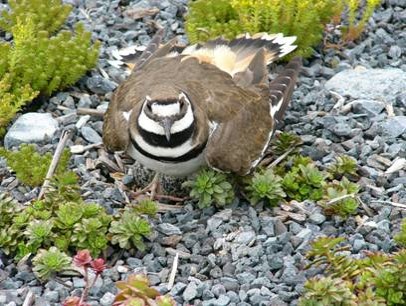The Benefits of Green Roofs Part 3: Habitat Creation
- Jimmy Dick
- May 19, 2017
- 2 min read

Another sometimes underappreciated benefit of green roofs is habitat creation and increased biodiversity. Rooftops can serve as refuge for creatures that struggle for survival, such as ground nesting and migratory birds. One example is the killdeer, they prefer open ground with low vegetation, they run across then stop to see if they startled up any insects for lunch.
These rooftops can create a migratory island for many different species of insects as well. On the California Academy of Sciences Building in San Francisco they are doing invertebrate research, have a native bee habitat, a red tail hawk flying school, also nesting killdeer. It’s roof top has 95 native plant species and over 1.7 million plants. At the University of the District of Columbia, they have attracted brown bumblebees, honeybees, carpenter bees, monarchs, swallowtails, butterflies and hummingbirds with native plants. They also grow herbs and vegetables for food preparation purposes, along with donations to local food pantries.
Typically, green roofs are designed to meet storm water management requirements, however there is a small push for biodiversity based design. So, no mention of biodiversity on rooftops of buildings without addressing little known brown roofs. Brown roofs are similar to green roof however they typically use local soils, plants indigenous to the area and wetlands encourage biodiversity, such as moss and lichen growth. Incorporating rocks, logs, small wetlands or pools and native plants will provide habitat for many more species. Rocks and logs are for perching birds to use while searching for food. The goal is for brown roofs to use 100% recycled materials, if possible, (the goal). Back one day in November of 2009, I wanted to see how hardy these plants were, so I build a small brown roof using a couple of buckets of construction debris, (drywall, broken tiles, glass) and a few shovels of compost, the sedums and grasses have flourished ever since.
Finally, I must also mention aquatic species and how they are positively affected by the increased installation of green roofs and green infrastructure. One example is rockfish, strippers or striped bass an anadromous fish that spends most of their time in the ocean and travels to freshwater to spawn. Rockfish are sensitive to habitat changes caused by land use- urbanization and development. This subject will be explored in greater detail in a future blog post.
Contact EQR:
As environmental construction experts for over 26 years, Environmental Quality Resources is proud of our mission of working outdoors to preserve and protect our watershed in a positive way. Visit us online or give us a call at (410) -923-8680 to get more information and see if we are what you’re looking for. Looking to see what we are currently working on and more about our company? Follow us on Facebook, Instagram, LinkedIn, Twitter, and YouTube!


















































Comments